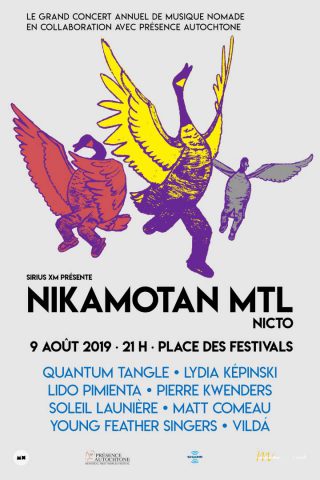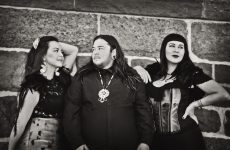“Let’s sing together” is an invitation that’s been extended for three years now in Atikamekw language by the Nikamotan MTL event. Being presented as part of the Présence autochtone (Montreal First Peoples) Festival, this new edition (dubbed “Nicto”, the Atikamekw word for “three”), remains faithful to its original mission of bridging cultures by promoting Indigenous artists from here and beyond.
 Nikamotan MTL is the main showcase of Musique Nomade, an organization created in 2006 by filmmaker Manon Barbeau on the same model as her famous Wapikoni Mobile. That mobile studio endeavoured to bring filmmaking and visual creativity to remote communities, and Musique Nomade is doing the exactl same thing for music. Their mobile studio brings equipment and resources to Indigenous communities in oder to create professional-quality recordings, but it mostly contributes to the creation of an emerging Indigenous artist network.
Nikamotan MTL is the main showcase of Musique Nomade, an organization created in 2006 by filmmaker Manon Barbeau on the same model as her famous Wapikoni Mobile. That mobile studio endeavoured to bring filmmaking and visual creativity to remote communities, and Musique Nomade is doing the exactl same thing for music. Their mobile studio brings equipment and resources to Indigenous communities in oder to create professional-quality recordings, but it mostly contributes to the creation of an emerging Indigenous artist network.
“We have three main mandates,” says Artistic Director Joëlle Robillard, also the Artistic Director of the Nikamotan MTL show. “First and foremost, we’re working to promote emerging artists from indigenous communities. There’s also a preservation role, through the building up of a kind of digital memory, for the broad purpose of keeping alive a culture that has been transmitted orally from time immemorial. Finally, we do representation work in festivals, which is another way of promoting talent both locally and internationally.”
Networking is being done both at the provincial and country-wide level, and also internationally as part of large folk music gatherings being held all over the world. It was thanks to her presence at events such as WOMEX and the Folk Alliance International that Robillard met the members of the Finnish group Vildá, a female duo that proudly carries the cultural torch of the Samis, an Indigenous people from the Laponian area. Vildá will be performing at the 2019 Nikamotan MTL festival. “Setting up an event with so many different parts is always stressful, particularly since we’re bringing together artists who sometimes don’t know each other, but it can produce magical matches. Sometimes, the artists themselves impact our programming: when I contacted (2017 Polaris Music Award winner) Lido Pimienta and asked her who she’d like to work with, she immediately suggested Pierre Kwenders.” A meeting between Africa and Latin America at a festival dominated by our own Indigenous cultures – that’s a great example of the kind of eclecticism being promoted by Musique Nomade.
Thanks to her involvement in the organization, Robillard is in a good position to attest to the strength of what Wolastoqiyik Nation and 2018 Polaris Music Award winner Jeremy Dutcher famously called the “Indigenous Renaissance.” And while the abundance of talent has never been in doubt, Robillard also noted that the audience is increasingly eager to discover new artists. “Music and the arts are powerful cultural reclamation tools for indigenous peoples,” she says. “So many unique voices are emerging, but one must know how to listen. And I’m not talking about the audience only: the entire music industry, which has often excluded Indigenous artists, must de-construct itself and start from scratch on a more inclusive basis.”
Still, one must admit that things are changing for the better. As a sign of the times, ADISQ will be presenting their first-ever Best Indigenous Artist Award during its next gala ceremony, a move most welcomed by Robillard. “I think ADISQ did the right thing by contacting communities and organizations such as ours,” she says. “They also adapted their selection criteria to make it possible for indigenous artists compete.”
Throughout our conversation, Robillard repeats that she sincerely hopes this renewed interest for Indigenous First Nation, Métis, and Inuit artistic productions will amount to more than a passing fad. “When you see the talent being deployed in the various Indigenous communities, there’s reason for optimism,” she says. “The first step in our work is to bring walls down; but we must move further and build solid foundations upon which that culture can grow.”
August 9, 2019,
at Place des Festivals, Montréal
 Matt Comeau
Matt Comeau“We discovered him while travelling through the Maritimes, and he’s one of the most luminous and engaging people there is,” says Joëlle Robillard. A member of the Mi’kmaq Nation, New Brunswick singer/guitarist Matt Comeau is featured on the All my People EP that was created during a workshop set up by Musique Nomade at the Metepenagiag Heritage Park in in 2017. “He has the warmest voice, and he’s an outstanding guitarist who writes blues-tinged pop songs,” says Robillard.

This Innu multi-disciplinary artist, originally from Mashteuiatsh, is, above, all “multi-talented,” according to Robillard. As the Indigenous artist-in-residence at Montréal’s National Theatre School, Soleil Launière works variously as an AUEN band member, an actor, and primarily as a performance artist. “Her movement performances are heavily influenced by the Innu culture and mythology,” says Robillard, “particularly through her evocation of the half-man-half-beast creatures depicted on our poster.”
 Quantum Tangle
Quantum Tangle
Originally from Yellowknife, Northwest Territories, Quantum Tangle won the 2017 JUNO Award for Indigenous Music Album of the Year, for Shelter As We Go. “I had wanted to schedule them for a long time,” says Robillard, “because I love their fusion of tradition and modernity, and their really cinematic sound. They use throat singing, usually performed a cappella by two women, in a completely different context. We suggested that they prepare something with Lydia Képinski, and they immediately went for it.